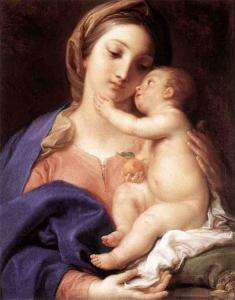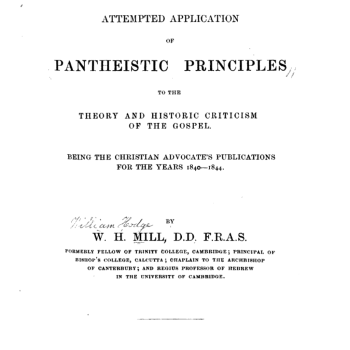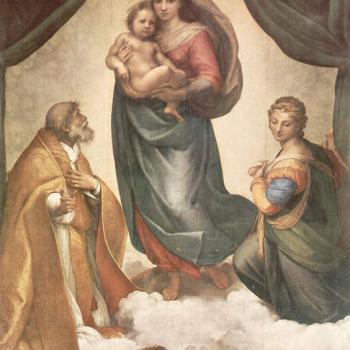Biblical Proof That Three Named “Brethren” of Jesus Are Non-Siblings + Harmonious 2nd Century Evidence Regarding the Fourth (Simon)
“Iceman2525” is some sort of Protestant. His Disqus profile offers no further information about him. Much of this exchange took place underneath my article, “Jesus’ ‘Brothers’: Anti-Catholic Lies from a Tiny Lutheran Sect (ELS).” I compiled my counter-responses into a new article: Dialogue w a Protestant on Mary’s Perpetual Virginity (1-2-23), which he has now responded to in turn. I appreciate the substantive, cordial dialogue.
His words will be in blue. I have made some slight editorial corrections or additions in his text (playing editor a bit).
*****
Thank you for sharing your article. There’s a few things I could challenge in the article but to keep this short I’ll limit [my response].
No need to keep it short. The more arguments, the merrier!
I don’t think all the adelphos usages for fellow countrymen or fellow believers really affects the other family relationship contested uses. By context we can nearly always know if adelphos is referring to a sibling/relative situation or fellow countrymen, non-related. Even today we can clearly know by context if someone is talking of an actual sibling or something else to refer to strong friendships, such as soldiers calling fellow soldiers their “brothers.”
One example: Paul uses adelphos as brethren/fellow believers almost entirely of course as that’s how he addresses church members in his writings. But this fact says nothing about how commonly adelphos is used for relative/kin.
I reviewed all the verses in Mark with adelphos, using a Bible app search. Ten uses definitely refer to siblings. One use was ambiguous. Six uses involved the contested Mark 3:31 – Mark 3:35 and Mark 6:3 passages.
In Matthew I found 30 verses with adelphos. Ten uses clearly mean sibling. Thirteen were for fellow countrymen or followers, and five uses concerned Jesus’ brothers. With just a few — like Matthew 10:21 — I’m not sure, but I doubt that cousin would fit the context.
So in my findings for Mark and Matthew regarding adelphos, I find twenty refer to actual siblings, thirteen to fellow countrymen, eleven in disputed Jesus’ brothers passages, and maybe three are ambiguous, but [in my opinion] I can’t fit cousin into the context of any of them.
Since twenty usages refer to siblings and I can’t find any other passage in Matthew or Mark where “cousin” would fit in context, I believe this gives strong weight to [the view that] adelphos [in the] Jesus/brothers passages refer to actual brothers and not cousins. I really don’t have time now to examine the rest of the New Testament, but I think this is a fair start.
I can, of course, elaborate on my findings if you have questions. Thank you.
I appreciate all this research and your response. We both have researched and written extensively about the usages of adelphos. I believe that what we can readily agree upon is the fact that examinations of variable usage alone are not the definitive solution to the determination of the exact nature of Jesus’ “brothers” in the NT. We will have to look at those passages in particular and see whether any exegetical or cross-referencing considerations can give us any solid clues as to what we’re disputing.
I have done that already in many papers of mine, which is why I urged you last time to grapple with some (hopefully much) of that, so that this dialogue can helpfully advance to the next stage. I summarized these sorts of arguments that I have made (and that Catholics and others who agree on this doctrine with us traditionally have made), in my article, “Jesus’ ‘Brothers’: Anti-Catholic Lies from a Tiny Lutheran Sect (ELS).” Here are two that specifically look at the most relevant passages:
In comparing Matthew 27:56, Mark 15:40, and John 19:25, we find that James and Joseph (mentioned in Matthew 13:55 with Simon and Jude as Jesus’ “brothers”) are the sons of Mary, wife of Clopas. This other Mary (Mt 27:61; 28:1) is called the Blessed Virgin Mary’s adelphe in John 19:25. Assuming that there are not two women named “Mary” in one family, this usage apparently means “cousin” or more distant relative. Matthew 13:55-56 and Mark 6:3 mention Simon, Jude and “sisters” along with James and Joseph, calling all adelphoi. The most plausible interpretation of all this related data is a use of adelphos as “cousins” (or possibly, step-brothers) rather than “siblings.” We know for sure, from the above information, that James and Joseph were not Jesus’ siblings. . . .
Jude is called the Lord’s “brother” in Matthew 13:55 and Mark 6:3. If this is the same Jude who wrote the epistle bearing that name (as many think), he calls himself “a servant of Jesus Christ and brother of James” (Jude 1:1). Now, suppose for a moment that he was Jesus’ blood brother. In that case, he refrains from referring to himself as the Lord’s own sibling (while we are told that such a phraseology occurs several times in the New Testament, referring to a sibling relationship) and chooses instead to identify himself as James‘ brother. This is far too strange and implausible to believe. Moreover, James also refrains from calling himself Jesus’ brother, in his epistle (James 1:1: “servant of God and of the Lord Jesus Christ”): even though St. Paul calls him “the Lord’s brother” (Gal 1:19).
Let’s look at these matters more closely:
Matthew 27:56 (RSV) among whom were Mary Mag’dalene, and Mary the mother of James and Joseph, . . .
Mark 15:40 There were also women looking on from afar, among whom were Mary Mag’dalene, and Mary the mother of James the younger and of Joses, and Salo’me,
John 19:25 . . . But standing by the cross of Jesus were his mother, and his mother’s sister, Mary the wife of Clopas, and Mary Mag’dalene.
There is some significant early patristic evidence (see more on this below) suggesting that Clopas was St. Joseph’s brother, in which case, Mary his wife would be the Blessed Virgin Mary’s sister-in-law (which would be in the range of uses for adelphe: “sister”). If that is the case, then James and Joseph / Joses would be Jesus’ first cousins, or more accurately, his step first cousins (Joseph not being literally His father). Note that this is not consistent with the “sons of Joseph from a previous marriage” / “Epiphanian” explanation.
Moreover, if someone wishes to assert that this “other Mary” (Mt 27:61; 28:1), who is described as the mother of James and Joseph (Mt 27:56; Mk 15:40), is Jesus‘ mother, that’s a real stretch, since it would entail her being described in two passages as the mother of these two or three persons, but not the mother of Jesus: Whose crucifixion she was watching at that very moment. That’s simply not plausible at all. Besides, in John 19:25, the two Marys are shown to be “sisters” (which can have meanings other than sibling). It seems obvious that they would not be siblings, having the same name, so sister-in-law or cousin makes much more sense.
This is why it is so important to synthesize and harmonize all the information that we can obtain in the four Gospels. Whoever believes in biblical inspiration holds that they are all harmonious, since the omniscient God is the ultimate author.
The named “brothers” of Jesus are James, Joseph, Simon, and Jude. Unnamed “sisters” are also mentioned (Mt 13:55-56; Mk 6:3). We know for sure that this “other Mary” is the mother of two of the four named “brethren” (James and Joseph). So that is virtual proof that 50% of the named brethren are children of Mary Clopas, the “other Mary”, whereas neither they nor any of the others (named or not) are ever called sons of the Blessed Virgin Mary: mother of Jesus. This is what the Bible informs us. I didn’t make it up! Catholics didn’t pull it out of a hat like a rabbit. This is God’s inspired revelation: the Holy Bible.
If two of these four named persons are known to be cousins, with a different mother than Jesus’ mother, then it is perhaps more likely (though not provable) that the whole group are non-siblings. Furthermore, it is known that extended families were the norm in ancient Israel (as indeed they probably still are today). I wrote abut this aspect in my article, Jesus’ “Brothers” Always “Hanging Around”: Siblings? [National Catholic Register, 5-11-18]. Here is one portion of that:
The Eerdmans Bible Dictionary (edited by Allen C. Myers, Grand Rapids, Michigan: Eerdmans, rev. ed., 1975) makes the nature of the Israelite family very clear, by noting that it could include more than one nuclear family (thus, cousins would be residing together):
The basic social unit, comprised of persons related by kinship and sharing a common residence. The Israelite family was an extended family known as the “father’s house” or “household” (Heb. “bet-ab”), consisting of two or more nuclear families (i.e., a married couple and their children) or composite families (an individual with multiple spouses and their offspring) . . . other kin (including grandparents), servants, concubines, and sojourners might also be reckoned part of the household (cf. Gen. 46:5-7, 26). (“Family,” p. 376)
Moreover, on the next page, this reference work noted that clans also usually “occupied the same or adjacent towns.” Extended families stuck together. It was like a perpetual family reunion. This would account for first or second or third cousins (all referred to as “brothers” in Semitic or Near Eastern culture: then and now) “hanging around” in one place.
Commenter Alex Lielbardis brought up this further argument:
Mark 6:4 And Jesus said to them, “A prophet is not without honor, except in his own country, and among his own kin [(συγγενής, ές / suggenes)], and in his own house.” (cf. Jn 7:5: “For even his brothers did not believe in him.”)
He added:
The plural Greek word used refers to kinsfolk, relatives, or fellow countrymen. This same word is used by Luke in his account of the Annunciation which in the singular form specifically means a cousin: “And behold, your kinswoman [συγγενίς / syngenis] Elizabeth in her old age has also conceived a son; and this is the sixth month with her who was called barren” (Luke 1:36). Thus, Jesus apparently replies with his cousins (relatives or kin) in mind, in response to what was said by those who were offended at him.
As for Jude, I made my argument above. He called himself “a servant of Jesus Christ and brother of James” (Jude 1:1). Now, we’re supposed to believe that if he were literally Jesus’ sibling, this is how he would describe himself? That makes no sense whatsoever and stretches credibility beyond the breaking point. The fact that he says he is James’ brother is our first clue that he is the same person as the “brother” Jude. James does the same, writing that he was a “servant of God and of the Lord Jesus Christ” (Jas 1:1), while St. Paul calls him “the Lord’s brother” (Gal 1:19). All of this fits in perfectly with the “cousins” explanation. It does not harmonize with a “siblings” interpretation.
The only question remaining concerning this “brother” Jude, is whether he is the same person who wrote the epistle of Jude. The New Bible Dictionary (Eerdmans, 1962, “Jude, Epistle of”) states:
In the early Church there was only one James who could be referred to in this way without further specification — ‘James the Lord’s brother’ (as he is called in Gal. 1:19). This points to an identification of the author with the Judas who is numbered among the brothers of Jesus in Mt. 13:55 and Mk 6:3 . . . (p. 675)
[T]hough he does not say [in Jude 1:1] which James he has in mind, it is generally held that this must be James the brother of Jesus, . . . If so, Jude is himself a brother of Jesus (Mark 6:3). (p. 459)
[I]t seems that the brothers preferred to see themselves as servants of Christ rather than to claim kinship. In a spirit of true Christian humility, they preferred to class themselves with other believers rather than to take up a position that might be thought to assume a specifically close connection with Jesus. (p. 459)
After the martyrdom of James and the conquest of Jerusalem which immediately followed, it is said that those of the apostles and disciples of the Lord that were still living came together from all directions with those that were related to the Lord according to the flesh (for the majority of them also were still alive) to take counsel as to who was worthy to succeed James.
They all with one consent pronounced Symeon, the son of Clopas, of whom the Gospel also makes mention; to be worthy of the episcopal throne of that parish. He was a cousin, as they say, of the Saviour. For Hegesippus records that Clopas was a brother of Joseph. (Book III, section 11, parts 1-2; translated by Arthur Cushman McGiffert. From Nicene and Post-Nicene Fathers, Second Series, Vol. 1. Edited by Philip Schaff and Henry Wace. [1890], pp. 123-124 in the version translated by G. A. Williamson, Baltimore: Penguin Books, 1965; cf. Book III, section 32, part 4: “Mary, the wife of Clopas, who was the father of Symeon” and Book III, section 32, part 1: “Symeon, the son of Clopas”)
Hegesippus also describes the beginnings of the heresies that arose in his time, in the following words, rescued from oblivion by Eusebius:
And after James the Just had suffered martyrdom, as the Lord had also on the same account, Symeon, the son of the Lord’s uncle, Clopas, was appointed the next bishop. All proposed him as second bishop because he was a cousin of the Lord. (Book IV, section 22, part 4; Williamson translation, p. 181)
Thus, at this point, we have express biblical evidence that James and Joseph are sons of Mary Clopas; “the other Mary” and not of the Blessed Virgin Mary. It’s most plausible to hold that Jude also was; or was, at least, not a sibling. Now, thanks to Hegesippus, we know that Simon, or Symeon (a variant of Simon; see, e.g., Acts 15:14; 2 Pet 1:1), was also a son of Clopas and the “other Mary”; therefore also a cousin of Jesus and not a sibling.
Hegesippus confirms that Simon: mentioned together with James and Joseph and Jude in Matthew 13:55 and Mark 6:3, is the son of Mary wife of Clopas, who was an aunt of Jesus (St. Joseph’s brother and his and Mary’s sister-in-law). Scripture directly affirms that James and Joseph were the sons of Mary and Clopas (Mt 27:56; Mk 15:40).
These are my exegetical arguments regarding three of the four named brothers, and additional early patristic evidence for the fourth. I think they need to be grappled with by those who think that Jesus had literal siblings, so that Mary was not a perpetual virgin, which would disprove a Catholic and Orthodox dogma and also the belief of all of the Protestant founders and earliest leaders. If our Protestant brethren want to “argue Bible”, I’ve done that and am always more than willing and happy to do so. I think I have presented some very strong biblical arguments above, with also some good corresponding patristic evidence.
Lastly, “Iceman2525” previously stated:
If the popular tradition before Jerome was that Jesus’s brothers were from Joseph’s prior marriage, then I find it odd for Catholics to support any other theory/tradition that would come later from Jerome.
I have provided strong evidence for the “cousins” theory both from the Bible itself (and of such a nature that contradicts the step brothers theory), and also from the second century (Hegesippus, cited by Eusebius). So it is incorrect to claim that Jerome invented or first wrote about this in the 4th-5th centuries. Hegesippus died about 162 years before Jerome was born. Even Eusebius, who recorded Hegesippus’ mostly lost words, died a few years before Jerome’s birth.
I don’t have time to go through all the usages and determine when “cousin” or any other non-sibling was meant, but it surely must be a lot of times. [italics added presently]
However, my review of the four Gospels has shown zero usages for cousins (I’m excluding the usages referring to Jesus’s brothers).
But the “brothers” are what we are discussing! I have shown that Joseph and James are Jesus’ cousins; therefore, when they were called adelphos / brothers, it meant, in fact, cousin. So adelphos meant cousin in at least those two cases.
So far my assumption would be that a cousin meaning would be an uncommon one. Yet if there are lots of cousin usages in NT besides the ones you site relating to Jesus then please share.
I’ve shown that two of the four “brothers” were cousins. That’s what matters in this discussion. You have to now directly grapple with that.
For the gospels of Matthew, Mark, Luke and John I found adelphos usage 41 times clearly indicating actual brothers/sisters, and 19 uses for fellow countrymen/fellow believers.
That’s why I claimed that ” ‘cousin’ or any other non-sibling” was the meaning “a lot of times.” You have verified 19 of these. Thanks for making my point!
18 were associated with Jesus. Maybe three other verses not clear enough but context doesn’t seem to support any meaning for cousin.
Disregarding all the counts associated with Jesus brothers I find it interesting that I found over forty instances of adelphos used for sibling and zero uses for cousin. Yet we are supposed to believe the only exceptions to the overwhelming meaning as sibling are when it’s used concerning Jesus’s brothers really means cousin.
Again, I am making arguments regarding the “brothers” of Jesus. You will have to address those eventually.
Your sorting out all the Mary’s as in John 19:25 is intriguing and something that can take a little time to sort out, as I still am [doing].
Fair enough.
You make some fair points and well thought out but can’t say you settled it.
Thanks! Then please show me where my argument for Joseph and James went astray.
You of course say there are three Marys listed but there are some who say the grammar shows four women. I have no Greek studies so I’m not qualified in this. But apparently the names Mary, James and Joseph were quite popular at that time and so very plausible two Marys could have sons with the same names.
Possible, but surely not “plausible” . . .
Plus Mark 15:40 calls this James “the less” along with Joses perhaps to erase confusion with James the Lord’s brother. But this whole sorting out all the Mary’s and who they are can be complex and as I see elsewhere there are a variety of theories.
As for Jude referring to himself as a “servant of Jesus Christ” instead of the Lord’s brother, this is nothing but an act of humility and putting Christ first. Should we expect Jude to go around town telling everyone “Hey! I’m Jude the Lord’s brother” with a proud look on his face?
You’re assuming that it must be an act of pride to do so. But that doesn’t follow. It could simply have a meaning of “hey, I grew up with Jesus [as His blood brother]! I know Him very well, so I have a strong basis for my opinions.”
Jude could go around calling himself the brother of Christ or recognize he is first a servant of Christ before anything else.
It’s not an “either/or” scenario. That’s where your premise is dubious.
Thank you again for your replies.
Thank you, too, for the continuing cordial interaction.
As I said before, I think we have exhausted the procedure of counting up uses of adelphos. I started to again directly examine the named “brothers” of Jesus (as I had already done at the outset). As far as I am concerned, it’s proven from cross-referencing that Joseph and James were His cousins: sons of the “other Mary” who is called the Blessed Virgin Mary’s sister (adelphe).
Do you grant that this is the case? If not, why? Your burden would then be to show from the Bible that they are actually siblings. Best wishes in that endeavor. But if you concede that point, then that’s half of the named “brothers” shown to be cousins (two of four), which is quite significant, I think.
I made a biblical argument from plausibility for Jude being a non-sibling. I think it works; you don’t. That’s the nature of those sorts of arguments; people disagree on what is plausible. They’re not airtight arguments, by their very nature. So there’s nowhere else to go with that.
My argument for Simon being a cousin came from early tradition (Hegesippus: 2nd century). This contradicted your claim that Jerome basically came up with the cousins theory much later. You’d have to tell me why you would question that (if you do).
***
See the follow-up article: Hegesippus (2nd c.) and the “Brothers” of Jesus (Including a “New” Argument from How Jesus is Described in Relation to Mary and Joseph) [1-5-23].
Practical Matters: Perhaps some of my 4,000+ free online articles (the most comprehensive “one-stop” Catholic apologetics site) or fifty books have helped you (by God’s grace) to decide to become Catholic or to return to the Church, or better understand some doctrines and why we believe them.
Or you may believe my work is worthy to support for the purpose of apologetics and evangelism in general. If so, please seriously consider a much-needed financial contribution. I’m always in need of more funds: especially monthly support. “The laborer is worthy of his wages” (1 Tim 5:18, NKJV). 1 December 2021 was my 20th anniversary as a full-time Catholic apologist, and February 2022 marked the 25th anniversary of my blog.
PayPal donations are the easiest: just send to my email address: [email protected]. You’ll see the term “Catholic Used Book Service”, which is my old side-business. To learn about the different methods of contributing, including 100% tax deduction, etc., see my page: About Catholic Apologist Dave Armstrong / Donation Information. Thanks a million from the bottom of my heart!
***
Photo credit: Madonna and Child (c. 1743), by Pompeo Batoni (1708-1787) [public domain / Wikimedia Commons]
***
Summary: I make a thorough response to Protestant arguments against Mary’s perpetual virginity, including exegetical proof that 75% of Jesus’ named “brothers” are non-siblings.













